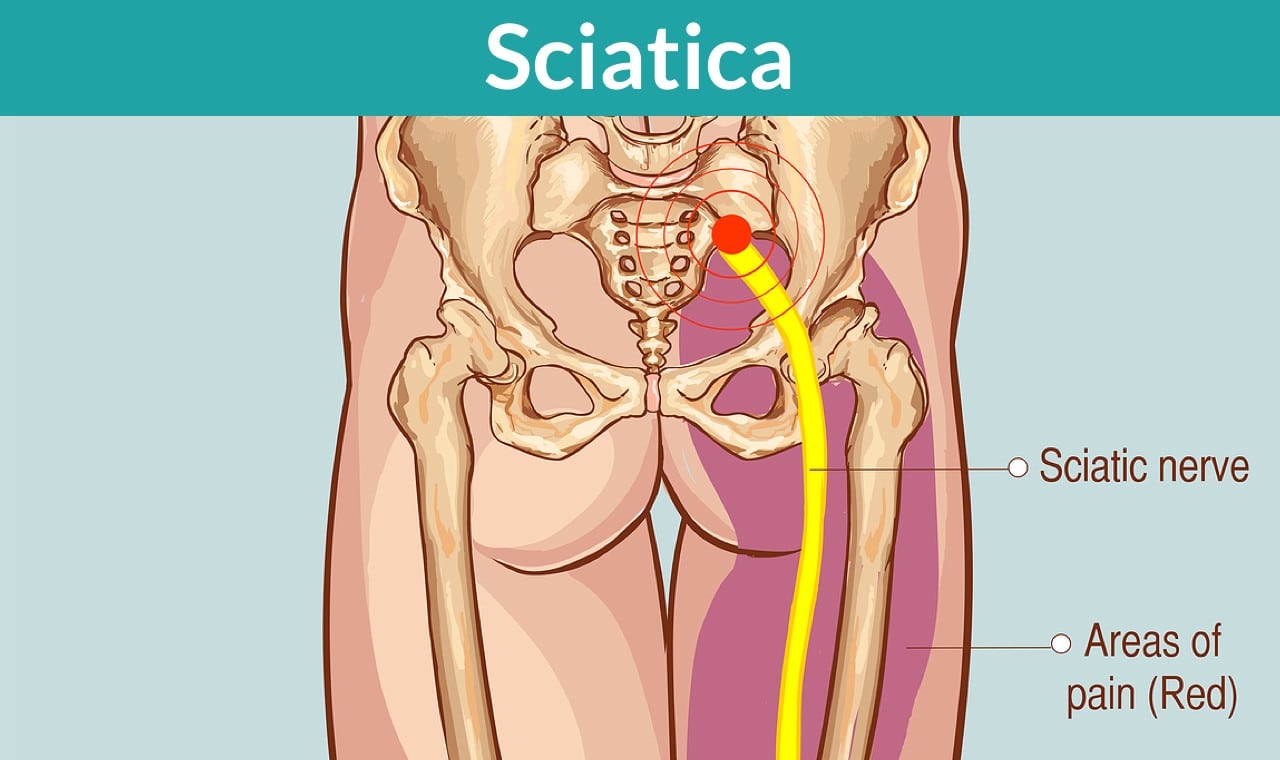
Sciatica is pain or numbness that travels down the back of the leg and comes from irritation of the sciatic nerve. It is pretty common, and no fun at all. This article goes into detail about how to relief your sciatica symptoms.
We actually have two sciatic nerves, one for each leg, and it is the biggest nerve in our bodies. The sciatic nerve begins at the pelvis, travels along the buttock, down the back of the thigh, to the back of the calf and ends at the foot. Sciatica is usually felt on one side at a time.
Sciatica is a result of irritation, pinching or pushing on the sciatic nerve, which can cause sharp pain, radiating pain down the leg or numbness.
When one or more discs of the lower lumbar spine (L4-S3) bulges or herniates, the disc then can compress on the nerve and/or cause chemical irritation of the nerve. Lumbar discs account for about 90% of all sciatica causes.
Spinal stenosis is the narrowing of the spinal canal and/or the foramen. This narrowing can affect the spinal cord or the nerves coming off the spinal cord. Stenosis is most often a result of degenerative changes like arthritis or bone spurs.
A spondylolisthesis, or spondy for short, is when the front of the vertebra is not completely connected to the back portion of the vertebra. This can cause the vertebra to slip forward and push on the nerves.
Injury to the nerve from the nerve being hit, overstretched, or fractured bones are possible causes of sciatica from trauma. Car accidents, direct contact like football or rugby, or falls are common reasons for trauma.
The piriformis is one of your buttock muscles and it sits right on top of the sciatic nerve in most people. In some people, the sciatic nerve pierces the piriformis. If the piriformis becomes over tight or spasms, usually from prolonged sitting, it can cause sciatica. One common cause of piriformis sciatica is sitting with a wallet in the back pocket.
Lumbar spine or pelvis tumors can grow large enough to cause sciatica. These tumors may be benign, like giant cell tumors or aneurysmal bone cysts, or malignant, like prostate cancer metastasis.
Some other causes of sciatica include pregnancy, endometriosis, diabetic neuropathy, or spinal infection.
Once your doctor determines the cause of your sciatica, treatment may include chiropractic adjustments, home exercises, massage, and daily activity changes.
When treating sciatica, the goal of chiropractic care is to reduce the compression and irritation of the sciatic nerve. The chiropractic adjustment may include manual or instrument techniques to increase motion and reduce pain. Chiropractic has been shown to be a very effective treatment option for sciatic symptoms.
Home exercise plans that focus on posture awareness, stretching, and strengthening are helpful in treating sciatica. Core stability exercises, leg flexibility, and nerve flossing are some of the types of exercises that may help. Yoga is another option that can be added to your home exercise program.
Massage is a good addition to your treatment of sciatica and can help relax the muscles or relieve trigger points. Massage will only get you so far though and should be used in conjunction with chiropractic and home exercises to get the best results.
If you add chiropractic, home exercise, and massage, but don’t change those small daily activities then there is a good chance that you will continue to have episodes of sciatica. Learning how to properly lift, bend, twist, and even sit are all necessary to make a longer-lasting change. And remember what I said about wallets too.
Some other treatment options may be helpful in reducing sciatica symptoms including:
Because sciatica is a term used to describe the symptoms and is not a specific condition, it can be a real pain in the butt to treat and should be treated as soon as possible. If your sciatica symptoms go all the way to the foot, it will take longer than if the sciatica only goes to her butt.
If you are ready to spend some time on yourself, work on a plan to keep moving, and to do what you love without out of pain. We are here for you.